Chengyang Bridge
The Yongji Bridge of Chengyang (simplified Chinese: 程阳永济桥; traditional Chinese: 程陽永濟橋; pinyin: Chéngyáng Yǒngjì Qiáo), also called the Chengyang Wind and Rain Bridge (simplified Chinese: 程阳风雨桥; traditional Chinese: 程陽風雨橋; pinyin: Chéngyáng Fēngyǔ Qiáo), is a bridge in Sanjiang County,[1] of Guangxi, China.
Chengyang Yongji Bridge 程陽永濟橋 | |
|---|---|
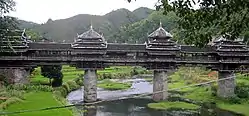 Chengyang Wind-Rain Bridge in 2003 | |
| Coordinates | 25°54′02″N 109°38′16″E |
| Locale | Sanjiang County, Guangxi, China |
| Characteristics | |
| Design | Covered bridge |
| Total length | 64.4 m (211 ft) |
| Height | 10 m (33 ft) |
| No. of spans | 3 |
| History | |
| Construction end | 1912 |
| Opened | 1912 |
| Location | |
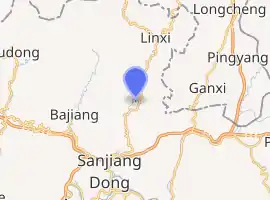
| |
Chengyang Bridge is a special covered bridge or lángqiáo, and one of several Fengyu bridges in the local Dong Minority region. It was completed in 1912. It is also called the Panlong Bridge (simplified Chinese: 盘龙桥; traditional Chinese: 盤龍橋; pinyin: Pánlóng Qiáo).
Properties
The bridge is a combination of bridge, corridor, veranda and Chinese pavilion. It has two platforms (one at each end of the bridge), 3 piers, 3 spans, 5 pavilions, 19 verandas, and three floors.[1] The piers are made of stone, the upper structures are mainly wooden, and the roof is covered with tiles. The bridge has wooden handrails on both sides.
The bridge has a total length of 64.4 metres (211 ft), and its corridor has a width of 3.4 metres (11 ft). The net height above the river is about 10 metres (33 ft).[2]
The bridge is located in Chengyang, and serves as the link between two populous villages.
Guo Moruo, a famous Chinese author, loved the bridge at first sight and wrote a poem for it.[2]
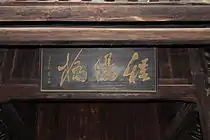 “程陽橋”, written by Guo Moruo
“程陽橋”, written by Guo Moruo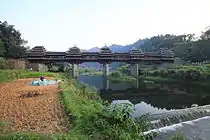 west of the bridge
west of the bridge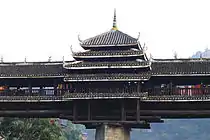
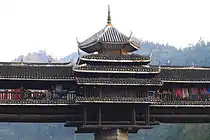


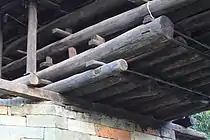

 south of the bridge
south of the bridge
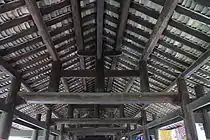
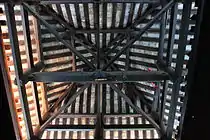
See also
- Xijin Bridge, another large covered bridge in Zhejiang, China.
References
| Wikimedia Commons has media related to Chengyang Yongji Bridge. |
- "程阳桥 (Chengyang Bridge)" (in Chinese). Tuniu. 2006-04-23. Retrieved January 2, 2010.
- "广西三江程阳风雨桥 (Guangxi Sanjiang Chengyang Wind-Rain Bridge)" (in Chinese). 中国网 (China.com.cn). 2002-05-21. Retrieved January 2, 2010.